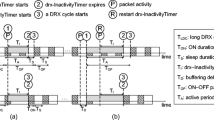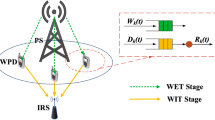Abstract
In all kinds of dynamic power management (DPM) policies, the timeout policy works perfectly in practice, but this could not be elucidated in the traditional queuing theory. With the pareto distribution, the drawback of the exponential distribution was overcome, and this phenomena was explained well. The conclusion provided the theoretical basis for the simplification of DPM algorithm. In this paper, a simple DPM algorithm was described when the length of idle time follows the Pareto distribution. The simulation result testified the conclusion above.
Preview
Unable to display preview. Download preview PDF.
Similar content being viewed by others
References
Benini, L., Micheli, G.: Dynamic Power Management: Design Techniques and CAD Tools. Kluwer Academic Publishers, Norwell (1997)
Douglis, F., Krishnan, P., Bershad, B.: Adaptive disk spin-down policies for mobile computers. In: The Second Usenix Symposium on Mobile and Location- Independent Computing (MOBLIC), pp. 121–137 (1995)
Helmbold, D., Long, D., Sherrod, B.: A dynamic disk spin-down technique for mobile computing. In: The Second Annual ACM International Conference on Mobile Computing and Networking (1996)
Douglis, F., Killian, T.: Adaptive modem connection lifetimes. In: The 1999 USENIX Annual Technical Conference, pp. 27–41 (1999)
Srivastava, M., Chandrakasan, A., Brodersen, R.: Predictive system shutdown and other architectural techniques for energy efficient programmable computation. IEEE Trans. on Very Large Scale Integration Systems 4, 42–55 (1996)
Hwang, C., Wu, A.: A sredictive system shutdown method for energy saving of event-driven computation. In: IEEE/ACM International Conference on Computer-Aided Design, pp. 28–32 (1997)
Lu, Y., Micheli, G.: Adaptive hard disk power management on personal computers. In: IEEE Great Lakes Symposium on VLSI, pp. 50–53 (1999)
Benini, L., Bogliolo, A., Paleologo, G., Micheli, G.: Policy optimization for dynamic power management. IEEE Trans. on Computer-Aided Design of Integrated Circuits and Systems 18, 813–833 (1999)
Qiu, Q., Pedram, M.: Dynamic power management based on continuous-time markov decision processes. In: The 36th ACM/IEEE conference on Design Automation Conference, pp. 555–561 (1999)
Simunic, T.: Energy Efficient System Design and Utilization. PhD thesis, Stanford University, Stanford, CA 94305, USA (2001)
Chung, E., Benini, L., Bogliolo, A., Lu, Y., Micheli, G.: Dynamic power management for nonstationary service requests. IEEE Trans. on Computers 51, 1345–1360 (2002)
Wu, Q., ze Xiong, G.: A study of the optimal policy of dynamic power management for pervasive computing system. To appear in Chinese Journal of Computers
Crovella, M., Bestavros, A.: Self-similarity in world wide web traffic. evidence and possible causes. IEEE/ACMTrans. on Networking 5, 835–846 (1997)
Taqqu, M.S., Willinger, W., Sherman, R.: Proof of a fundamental result in self-similar traffic modeling. ACM Computer Communications Review 27, 5–23 (1997)
Gribble, S.D., Manku, G.S., Self-similarity, D.R.: in file systems. In: The 1998 ACM Conference on Measurement and Modeling of Computer Systems (SIGMETRICS), pp. 141–150 (1998)
Harchol-Balter, M., Downey, A.: Exploiting process lifetime distributions for dynamic load balancing. ACM Trans. on Computer Systems 15, 253–285 (1997)
Harchol-Balter, M.: The effect of heavy- tailed job size distributions on computer system design. In: ASA-IMS Conference on Applications of Heavy Tailed Distributions in Economics (1999)
Greenawalt, P.: Modeling power management for hard disks. In: The Conference on Modeling, Analysis, and Simulation of Computer and Telecommunication Systems, pp. 62–66 (1994)
Author information
Authors and Affiliations
Editor information
Editors and Affiliations
Rights and permissions
Copyright information
© 2005 Springer-Verlag Berlin Heidelberg
About this paper
Cite this paper
Wu, Q., Xiong, Gz. (2005). Why Simple Timeout Strategies Work Perfectly in Practice?. In: Wu, Z., Chen, C., Guo, M., Bu, J. (eds) Embedded Software and Systems. ICESS 2004. Lecture Notes in Computer Science, vol 3605. Springer, Berlin, Heidelberg. https://doi.org/10.1007/11535409_68
Download citation
DOI: https://doi.org/10.1007/11535409_68
Publisher Name: Springer, Berlin, Heidelberg
Print ISBN: 978-3-540-28128-3
Online ISBN: 978-3-540-31823-1
eBook Packages: Computer ScienceComputer Science (R0)




